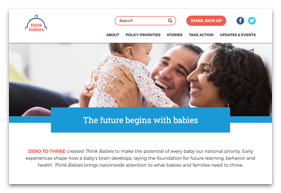
To promote all areas of development, children need safe and nurturing environments that include close caring relationships with their providers.
For Our Babies recommends policies and practices that support regulations emphasizing quality, therefore elevating the profession of infant/toddler teaching and child care subsidies for all.
Regulations that emphasize quality
The Crisis
Of the 12 million infants and toddlers in the United States, more than half spend some or all of their day being cared for by someone other than their parents1. Studies show fewer than 10 percent of child care arrangements provide high-quality care2.
Why It Matters
Infants and toddlers are not able to defend their right to safe and engaging child care. Therefore, adults must protect them from potentially dangerous and harmful experiences. All of society benefits when regulations are in place to ensure that care is provided in safe, engaging, and intimate settings.
We Recommend
Child care regulations that ensure care is provided in safe, engaging, and intimate settings
In the Library
Featured resources about regulations that
emphasize quality See all
Elevating the profession of infant/toddler teaching
The Crisis
In the United States, the turnover rate for infant/toddler caregivers is an alarming 30 percent annually and 75 percent every four years. Infant care teachers in the United States are among the poorest paid, earning approximately $10 per hour, less than the wages of an average dog walker3.
Why It Matters
Instability erodes the quality of care experienced by children. Relationships with caregivers that can grow and strengthen over time are essential to healthy social and cognitive development. The only way to attract and retain a well-qualified professional workforce is to pay and train people accordingly.
We Recommend
Training, compensation, and professional stature for infant/toddler teachers at the same level enjoyed by K–12 teachers
In the Library
Featured resources about elevating the profession of infant/toddler teaching See all
Child care subsidies for all
The Crisis
In no state does the cost of center-based infant/toddler child care meet the federal definition of affordable — no more than 7 percent of annual household income. In 12 states, the cost of child care for just one infant exceeds 20 percent of the state median income4. Nationally, the price of center-based child care for infants can cost single-parent families an average of 36 percent of household income5.
Why It Matters
Quality infant/toddler care remains unaffordable for most American families. When children can’t access high-quality care, they are less likely to be ready for kindergarten. From an economic standpoint, without quality care, families may not be able to work. Businesses see lost profits and productivity because of employee turnover and absenteeism. Furthermore, financial instability of families can put a strain on government assistance programs6.
We Recommend
Child care subsidies for all families
In the Library
Featured resources about child care subsidies for all See all
What you can do
Think Babies
ZERO TO THREE created Think Babies to make the potential of every baby our national priority and focuses on five key policy areas: paid leave, child care, Early Head Start, home visiting, and infant and early childhood mental health. The website has links for many ways to take action on each of the policy areas.
- Mamedova, S., Redford, J., & Zukerberg, A. (2013). Early Childhood Program Participation Survey, from the National Household Education Surveys Program of 2012: First look. National Center for Education Statistics. https://nces.ed.gov/pubsearch/pubsinfo.asp?pubid=2013029rev
- U.S. Department of Health and Human Services. (2006). The NICHD study of early child care and youth development. https://www.nichd.nih.gov/sites/default/files/publications/pubs/documents/seccyd_06.pdf
- McLean, C., Whitebook, M., & Roh, E. (2019). From unlivable wages to just pay for early educators. Center for the Study of Child Care Employment. https://cscce.berkeley.edu/from-unlivable-wages-to-just-pay-for-early-educators/
- Workman, S., & Jessen-Howard, S. (2018). Understanding the true cost of child care for infants and toddlers. Center for American Progress. https://www.americanprogress.org/issues/early-childhood/reports/2018/11/15/460970/understanding-true-cost-child-care-infants-toddlers/
- Child Care Aware. (n.d.). The US and the high price of child care: An examination of a broken system. http://usa.childcareaware.org/priceofcare
- Child Care Aware. (n.d.). The US and the high price of child care: An examination of a broken system. http://usa.childcareaware.org/priceofcare









